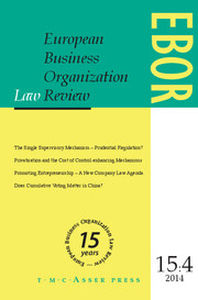No CrossRef data available.
Article contents
Disintegrating the Regulation of the Business Corporation as a Nexus of Contracts: Regulatory Competition vs. Unification of Law*
Published online by Cambridge University Press: 19 May 2009
Abstract
We apply the paradigm of the firm as a nexus of contracts to the debate on regulatory competition vs. unification of law as an alternative way of regulating the business corporation. This approach views the business corporation as a set of coordinated contracts among different parties. Agency problems and related agency costs are the result of this interaction. The economic analysis of corporate law, securities regulation and bankruptcy law identifies law as a means to minimise such agency costs. In this paper, we develop a model where companies are heterogeneous in their preferences about the legal regulation of contractual relationships. We then compare a regime of regulatory competition with one of single supply of regulation and we analyse their relative costs and benefits.
Keywords
Information
- Type
- Articles
- Information
- Copyright
- Copyright © T.M.C. Asser Press and the Authors 2009
References
* We wish to thank Rainer Kulms, Francisco Marcos and Ernesto Savaglio for their helpful comments. Furthermore, we thank Luca Enriques, Luigi Alberto Franzoni and Emanuela Carbonara for their comments on a very preliminary version of this paper. We also thank all the participants in the EMLE Midterm Meeting 2005/2006 at the University of Hamburg, in the EALE Conference 2006 and in the SIDE Conference 2006. Finally, we thank the anonymous referee. The usual disclaimers apply.
Although this article was elaborated jointly by the authors, for the purpose of academic evaluation it has to be stressed that, according to the respective scientific competences, sections 2 and 3 were written by Stefano Lombardo while section 4 as well as the mathematical appendix were drawn up by Piero Pasotti.

